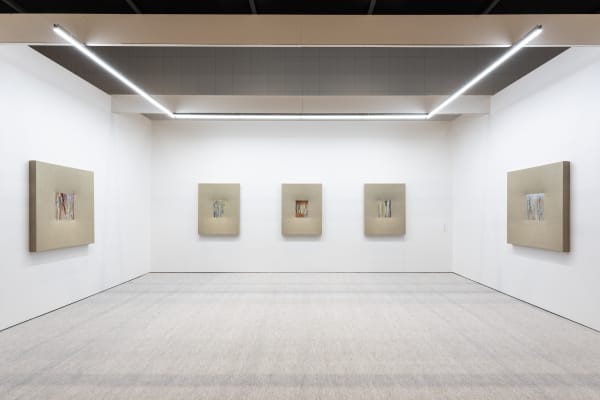Taro Shinoda: Art Collaboration Kyoto
Past exhibition
Overview
Booth KM09
Works from Katsura series (2020)
Taro Shinoda’s Katsura works employ basic oil painting materials, sizing linen canvas with rabbit skin glue and using walnut oil as a painting medium. Nevertheless, they are distinctly unlike the conventional paintings that we are familiar with. Standing in front of one of these works, viewers feel unsure about what distance and what angle to view the painting from. Extending inwards from the edges of each work is a large margin of linen canvas, which curves away from the viewer as it approaches the center, creating a depression with a depth of about 5 centimeters. In the center is a fat area covered by an abstract composition of colors and grid lines, painted with oil paints. As part of the process behind the production of these paintings, Shinoda found his way to Katsura Rikyu, the Katsura Imperial Villa on the outskirts of Kyoto. Perceiving that the Japanese aesthetic concept of structure differs from the commonly-taught dimension-based concept grounded in two- and three-dimensional structures, Shinoda endeavored to bring out that difference in these paintings by giving emphasis to the elements of Japanese architectural tradition as symbolized by Katsura Rikyu. In the sense of taking time and space as a single lineage, his new paintings approach the structure of Katsura. “What I was attempting to do in these paintings is not consistent with the so-called Western approach to painting. They are paintings in appearance and shape, and formally they can be described in the context of painting, but these are not works that emerged as part of such a stream or such trends.” Shinoda had felt ill at ease with the Western understanding of time and space ever since his early career as a landscape architect specializing in traditional Japanese gardens, and he began to wonder how he had acquired his own ideas of time and space. The distance from which we view a painting can be thought of as a physical action based on components of our shared awareness and on the ways of living, society, and culture that are extensions thereof. This new series, Katsura, derives from revisiting that thinking to question once more the premises that lie behind it.
Installation Views









